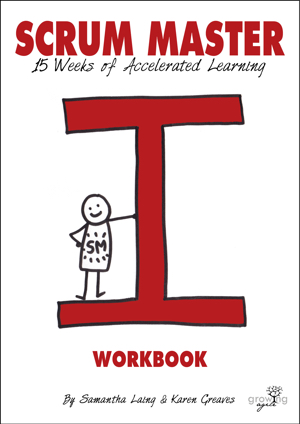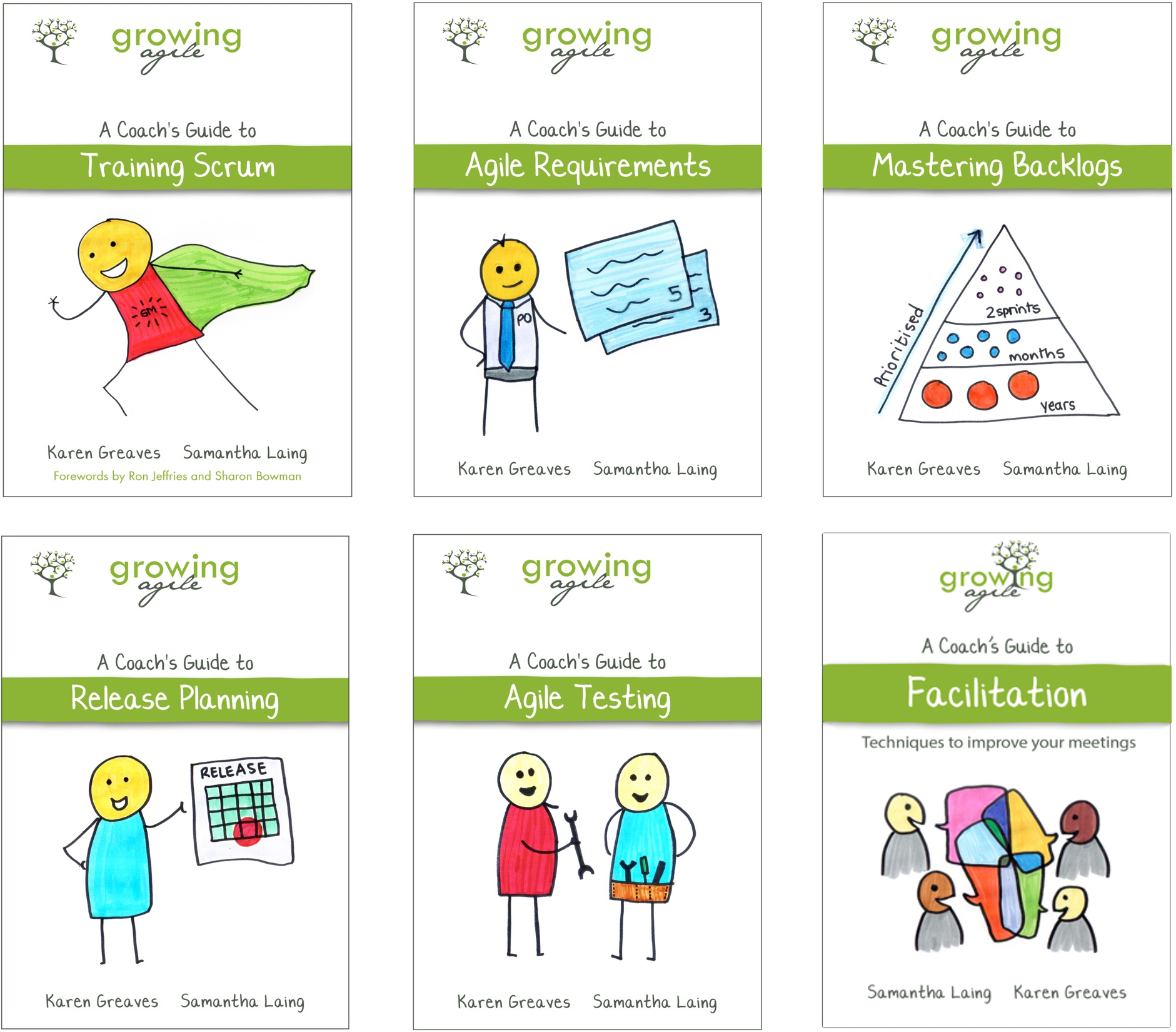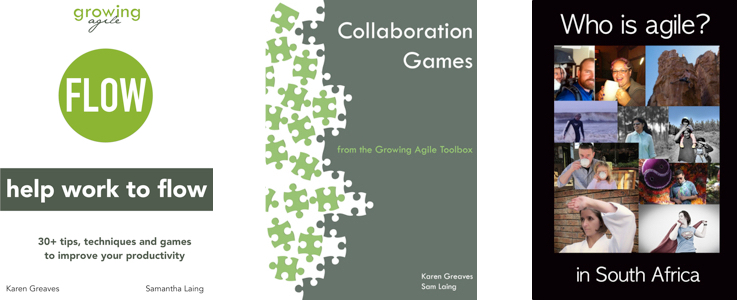Table of Contents
About the Authors

Let’s introduce ourselves. We are Karen Greaves and Sam Laing, the dynamic duo behind Growing Agile. With a passion for all things Agile, we have dedicated ourselves to empowering agile coaches and teams with our innovative and time-saving solutions.
We have worked in software our whole lives. With Type A personalities and a strong work ethic, we have both done our share of overtime on death march projects. Eventually we knew we had to find another way. Agile brought us together when we worked at a company trying to do Scrum for the first time. Join us on our journey to make agile training more engaging and effective than ever before!
If you’d like to contact us, you can email on karen.greaves@gmail.com and samantha.laing@gmail.com.
Facilitation
Introduction
Welcome to our book on Facilitation. This book is a collection of facilitation techniques we continually use in workshops, training courses, meetings and retrospectives. Although we will use the term meeting as a general word in this book, it applies to all of the above.
It’s taken us several years to master the skill of facilitation, and it continues to amaze us how few people learn the skill, or even understand what it means. People spend much of their lives in meetings, and yet so many meetings lack facilitation. We hope this book will inspire you to grow your own facilitation skills and improve the meetings in your organisation.
Who is this book for
Anyone who attends meeting can benefit from this book. However we are specifically aiming the book at people who regularly run meetings, workshops or training sessions. You might call yourself a facilitator or trainer, but more likely you have another title and meetings are just how you interact with others to get things done.
We have used these techniques in many contexts:
- In person training sessions
- Remote phone based group coaching calls
- One on one coaching sessions
- In person team planning meetings
- Large group feedback sessions
- Conference organising committees
- Large conference workshops of over 100 people
- Executive strategy sessions at a board room table
- Distributed retrospectives for teams to improve
- Online video training courses
- Keynote talks to more than 300 people
Obviously not every technique works remotely as well as it does in person, and some techniques work better for smaller groups than larger ones, but most techniques can be adapted to your context given a bit of creativity.
About Facilitation
When training others in facilitation we like to use the following definition from Mindtools.
What a facilitator does is plan, guide and manage a group event to ensure that the group’s objectives are met effectively, with clear thinking, good participation and full buy-in from everyone who is involved.
From this definition you can see that there would be many benefits to a well facilitated meeting. Here are some of our favourites:
- Everyone is clear on the purpose of the meeting
- The time box of the meeting is respected: it starts and ends on time (or early).
- All participants have an opportunity to contribute.
- Clear decisions are made in the meeting.
- Everyone stays engaged throughout the meeting: no one checks email, or plays with their phone.
- Concrete followup actions are agreed and assigned owners so that they actually get done.
- Everyone leaves the room on the same page.
- No one feels the meeting was a waste of time.
The importance of planning
One of the most important things you need to do as a facilitator is prepare for and plan the meeting. This is an often overlooked activity. According to Jean Tabaka in Collaboration Explained, it can take twice the length of the meeting to prepare adequately for a meeting. We believe this can be less (about the same length as the meeting) with lots of experience and a well developed toolkit.
How to use this book
The techniques in this book can help you prepare and plan for a meeting. Although there are a number of different meeting formats you can choose to follow, we find most meetings include 4 key parts.
These are:
- Starting
- Diverging
- Converging
- Closing
Starting
Lots of people use the term ‘ice-breakers’ to refer to an activity at the start of a meeting to get people talking to each other. We don’t like the phrase, maybe because we’ve seen people use the phrase for activities that are completely unrelated to the topic of the meeting. We prefer the phrase ‘Check in’.
For us a check-in activity has 3 purposes:
- To get everyone in the room to talk in the first 5 minutes of the meeting. Evidence suggests that if they do, they are more likely to contribute in the rest of the meeting.
- To connect people to the topic of the meeting, and in particular how they feel about the topic, or what they know.
- To connect people to each other and establish some trust or relationships in the room. This is greatly dependant on: who the audience is, if they know each other, and how much trust you need in the room for the meeting you are going to have. All of these are things you need to consider in your preparation.
Diverging
Most meetings require participants to brainstorm a wide variety of things. For example topics to discuss, challenges to address, decisions to be made, etc. For anything like this it is important to include activities that help people diverge. That is to create lots of ideas before they decide which to focus on. The reason for this is that most of our best thinking doesn’t happen immediately. It also helps a group collaborate and create an idea together by building on each other’s ideas. We call this the diverging part of a meeting. Depending on the type of meeting you might have several diverting parts to your meeting.
Converging
While creating lots of ideas is a really useful technique, meetings that don’t bring those together into an agreed decision or action step, are often a waste. Therefore most meetings require a converging phase where participants select which ideas they want to try, or choose the best course of action. A converging phase follows a diverging phase. Again you could have multiple of these in a meeting.
Closing
Wrapping up or closing a meeting is also crucial. Many meetings that run over time neglect this part completely. Closings can help people feel their time was valued. It also gives the facilitator an opportunity to get feedback on their facilitation. Finally it is a great time to wrap up by reminding people of their actions, and agreeing the next steps that will happen.
Below is a list of these 4 phases. Under each we have indicated which techniques that you find in this book could work for those phases. Note some techniques work well in more than one area. You can use this list to quickly find techniques you need to plan your meeting.
Techniques
Agreements
| 5 | any number | Communication | ||
| minutes | people |
When to use
This sets a tone and expectations near the start of a meeting. It helps the participants know what the boundaries of the meeting are, and what behaviours are acceptable.
What you need
It is best to have each agreement on a card and to go through them near the start of the meeting. These are in the Coach Toolkit.
How to do this
Decide which agreements are appropriate for your participants and meeting. Explain them clearly and simply near the start of the meeting.
You can also ask participants if there are any agreements they would like to add.
How we’ve used this
We change these depending on the type meeting we’re running. Over time you will learn more techniques and so this list will keep evolving.
Here are some of the cards we have:
- Take Care: Take care of your own needs. You don’t need to ask permission to go to the bathroom, or to get coffee.
- Cellphones: Keep your phones on silent please. If you need to take a call, just leave the room. We’d rather you were paying attention than worrying because your boss/wife/child is calling.
- Right to Pass: You have the right to pass in any activity or exercise we do. Just sit to the side and observe.
- Workbooks: These are yours to keep. Please take notes. We will let you know when we are doing specific exercises in the books.
- Timeboxing: We give a specific end time for each break. We will start at that time whether you are back or not. It’s up to you to choose to be on time or not.
Who shared this with us
Various people over the years, many from Sharon Bowman. We came up with the concept of using cards to remember all of the things we wanted to say.
Appreciations
| 5 | any number | Courage | ||
| minutes | people | Collaboration |
When to use
To build a culture of appreciation within a team and make the team members feel valued. Helps with collaboration amongst team members.
What you need
Nothing
How to do this
In any meeting introduce this technique by saying you would like to provide a space for people to recognise and appreciate anyone who has helped them recently. Ask people to try to give personal appreciations to individuals rather than to the whole team.
Take the lead and give an example by appreciating someone, e.g. “John, I’d like to appreciate you for the courage you showed in today’s session by voicing your doubts about the new process.”
Then be quiet. If this is the first time the group does this, it may take some time for the first person to speak. Just hold the silence, someone will speak. Remember to allow about a minute of silence before closing this session as some people take longer to speak than others.
How we’ve used this
- We have also asked participants to write down an appreciation, and pass it to that person. These are in the Coach Toolkit.
- Start with a ball of string and say an appreciation, throw the ball to the person you appreciated, but keep holding the end. They now give an appreciation and throw the string to that person. At the end you can see a web of how everyone is interconnected and collaborate together.
Who shared this with us
Esther Derby and Diana Larsen.
Ball Toss
| 5 | 5 - 25 | Movement | ||
| minutes | people | Feedback |
When to use
A good way to close a meeting with some movement, and to give people an opportunity to share their thoughts and give you some feedback.
What you need
A soft ball.
How to do this
Ask people to stand up and form a circle. If you have the space to do this away from tables then do so, but if not create a circle around the tables.
Explain that the ball is the speaking token. Then explain that you will pose a question for them to answer. If they would like to answer, they should signal to the person with the ball and they will gently toss it to them. They can then answer the question you posed.
Remind people that once they have answered they should look for someone else signalling that they want the ball. Often people get flustered and just throw the ball when they are done answering. Ask people a question about the meeting. Its a good idea to make this a one or two word answer to avoid any lengthly answers. For example: What is one thing that surprised you in this meeting?
Wait for someone to ask for the ball, then gently toss it to them. Once the ball stops moving for a while, you can signal for the ball again, and close the meeting by thanking people for their time.
How we’ve used this
- Use this to close the day on a one-day training course, by asking people to share one word that best describes the day for them.
- Use this to close retrospectives by asking people what their hope is for the next sprint.
Who shared this with us
Appendix
Recommended Reading List
Books
Agile Retrospectives by Esther Derby and Diana Larsen
Collaboration Explained by Jean Tabaka
Designing the Conversation: Techniques for Successful Facilitation by Russ Unger, Brad Nunnally and Dan Willis
The Facilitator’s Guide to Participatory Decision Making by Sam Kaner
Gamestorming by Dave Gray
The Graphic Facilitator’s Guide by Brandy Agerbeck
Impact Mapping by Gojko Adzic
Management 3.0 Workout by Jurgen Appelo
The Skilled Facilitator by Roger Schwarz
System’s Thinking Playbook by Linda Booth Sweeney and Dennis Meadows
Training From The Back of the Room by Sharon Bowman
Visual Meetings by David Sibbet
Visual Mojo by Lynne Cazaly
Websites
Growing Agile Books
Scrum Master Workbook - 15 Weeks of Accelerated Learning

Essential for new Scrum Masters! This is a workbook you print out and fill in each week. It will guide you through a range of topics that are critical for Scrum Masters to understand. Each week will include reading, exercises and a journal page for you to reflect. We also include cutouts for your toolbox on a range of different topics.
Scrum Master Workbook is available on Leanpub.
The Growing Agile Coach’s Guide Series
This series provides a collection of training and workshop plans for a variety of agile topics. The series is aimed at agile coaches, trainers and ScrumMasters who often find themselves needing to help teams understand agile concepts. Each book in the series provides the plans, slides, workbooks and activity instructions to run a number of workshops on each topic. The interactive workshops are all created using techniques from Training from the Back of the Room, to ensure participants are engaged and remember their learnings after the workshop.
The series is available in a bundle on Leanpub, or you can purchase the books individually.

Growing Agile: A Coach’s Guide to Training Scrum
We have been training teams in Scrum for about three years. During this time we have spent many hours preparing training plans and creating workbooks, flipcharts and slides. This book will help you plan and deliver interactive, fun Scrum training for anything from a short workshop on a particular topic to a full two-day course.
Growing Agile: A Coach’s Guide to Training Scrum is available on Leanpub.
A Coach’s Guide to Agile Requirements
Our requirement workshops are aimed at different stakeholders ranging from business, to Product Owners and teams. This book is a collection of some of those workshop and can be used to help improve the way you think about and communicate agile requirements.
Growing Agile: A Coach’s Guide to Agile Requirements is available on Leanpub.
Growing Agile: A Coach’s Guide to Mastering Backlogs
Often Product Owners can’t see the forest for the trees and there are so many items in their backlog and not enough hours in the day to groom it. We run short workshops where we work with the Product Owner’s actual backlog. The workshop is a working session, and an hour later the Product Owners emerge with an improved backlog.
Growing Agile: A Coach’s Guide to Mastering Backlogs is available on Leanpub.
Growing Agile: A Coach’s Guide to Release Planning
We often hear people say “We’re agile, we don’t need a plan”! or even worse “We can’t plan”. This is just not true. We run Release Planning workshops with many organisations. This book is a collection of our workshops that will help you run similar workshops to create agile release plans. We include teaching points on a range of techniques like Story Mapping and release burnups to help you explain to other’s how to use these methods effectively.
Growing Agile: A Coach’s Guide to Release Planning is available on Leanpub.
A Coach’s Guide to Agile Testing
If a team believes they are agile, but nothing has changed about the way they test, then there is still much to learn. We teach 5 key principles that explain why agile testing is fundamentally different to traditional testing.This books includes a collection of workshops to help teams grasp these principles and adopt an agile testing mindset. It’s not just for testers. A key part of agile testing is that the whole team is involved, so we always run these workshops with everyone in the team.
Growing Agile: A Coach’s Guide to Agile Testing is available on Leanpub.
Growing Agile: A Coach’s Guide to Facilitation
It’s taken us several years to master the skill of facilitation, and it continues to amaze us how few people learn the skill, or even understand what it means. People spend much of their lives in meetings, and yet so many meetings lack facilitation. We hope the collection of tips and techniques in this book will inspire you to grow your own facilitation skills and improve the meetings in your organisation.
Growing Agile: A Coach’s Guide to Facilitation is available on Leanpub.
Other books by Growing Agile

Flow
Do you have a never-ending to do list and not enough hours in the day? Imagine getting everything on your to do list done without stress or worrying. Imagine being twice as productive in half the time.
We have over 30 proven tips and techniques to help you achieve a state of flow, where time stands still and productivity soars. With these tips you will deliver value to your customers sooner in practical and simple ways. You will also be happier and less stressed.
Flow is available on Leanpub.
Collaboration Games
Add an element of fun to your meetings or workshops using these 12 short games that teach principles of collaboration.
Collaboration Games is available on Leanpub.
Who is Agile in South Africa
This book is based on the original Who Is Agile book, only this is a regional version for South Africa. It’s a collection of interviews with passionate South African agilists.
Who is Agile in South Africa is available on Leanpub.
